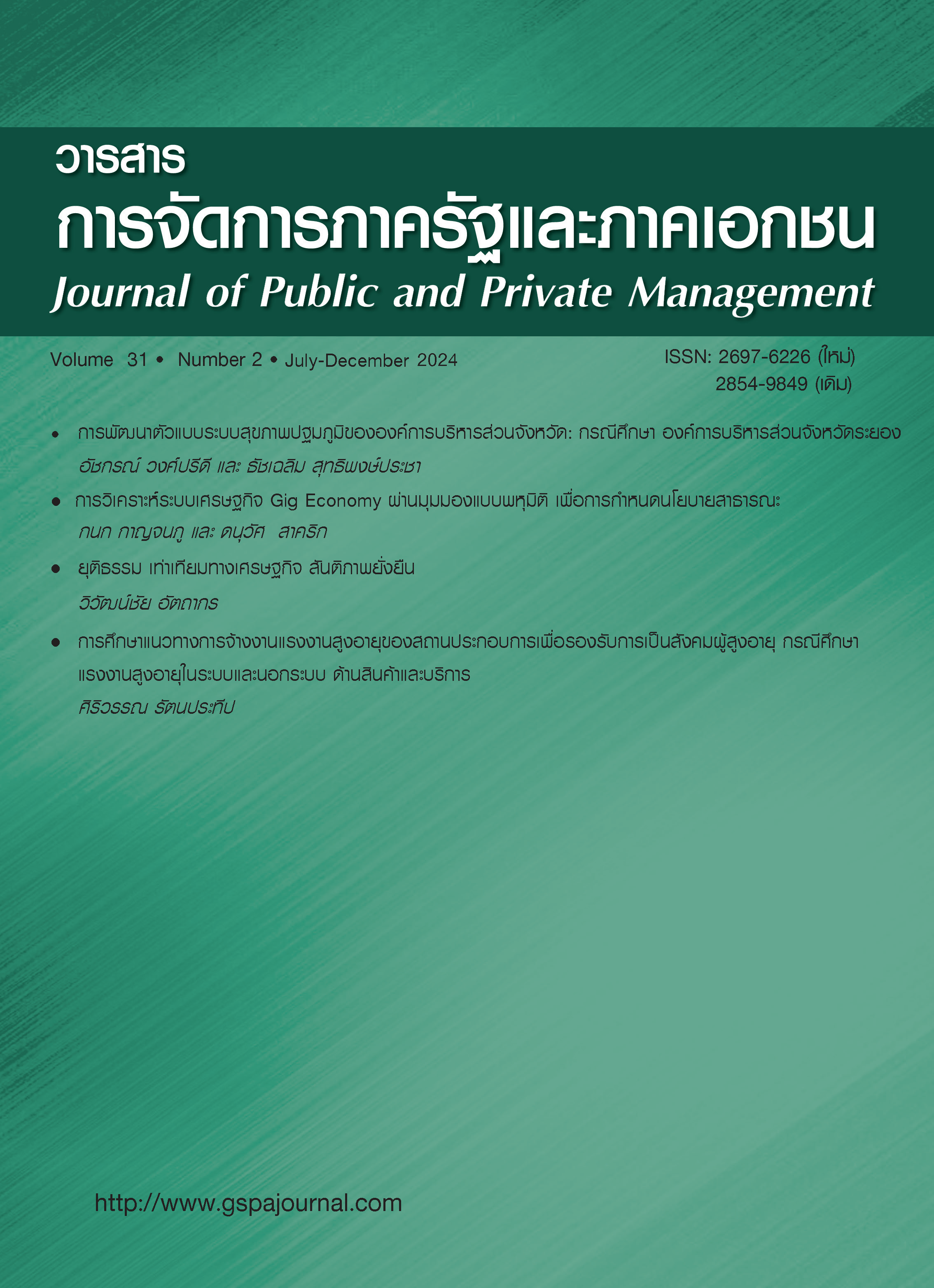The Multi-dimensional Analysis of Gig Economy for Public Policy Making
Keywords:
Gig economy, macroeconomy, future of work, public policy makingAbstract
This article aims to analyze various dimensions of the gig economy in Thailand by studying a series of perspectives across economic, social, and technological dimensions to gain a comprehensive and detailed understanding of the gig economy landscape in Thailand. Through qualitative research methods, including in-depth interviews with various groups of stakeholders such as platforms, government agencies, academics, and service providers or freelance workers, a multidimensional literature review was conducted. This review includes example cases from various countries. The study results reflect the important role of the gig economy system in driving the macroeconomy, social dynamics, and the adjustment of work in line with technological advancements in Thailand, both at present and in the future. It also reflects the views and ideas of relevant stakeholders, ready to present academic information that can be applied to policy-making in both the public and private sectors amid the changing context and landscape of work and economy in the 21st century.
References
Agrawal, A., Horton, J., Lacetera, N., & Lyons, E. (2013). Digitization and the contract labor market: A research agenda. Economic Analysis of the Digital Economy. National Bureau of Economic Research, 219-250.
Ahlberg, K., & Bruun, N. (2018). Gig economy in Sweden and its implications for social dialogue. Transfer: European Review of Labour and Research, 24(3), 333-347.
Airbnb. (2020). Airbnb 2020: A Year in Review. Retrieved from https://news.airbnb.com/airbnb-2020-a-year-in-review/.
Berg, J. M. (2016). Balancing on the creative highwire: Forecasting the success of novel ideas in organizations. Administrative Science Quarterly, 61(3), 433-468.
Catalant. (2019). The Future of Work: A Comprehensive Report. Retrieved from https://gocatalant.com/wp-content/uploads/2019/07/The-Future-of-Work-Report.pdf.
Chen, F., & Xu, X. (2018). Active labour market policies in the platform economy era in China. The International Journal of Comparative Labour Law and Industrial Relations, 34(1), 23-42.
Cohen, J., & Sundararajan, A. (2015). Self-employment and labor market transitions: Flexibility vs. stability. Journal of Labor Economics, 33(S1), S95-S121.
De Stefano, V. (2016). The rise of the "just-in-time workforce": On-demand work, crowd work, and labor protection in the gig-economy. Comparative Labor Law & Policy Journal, 37(3), 471-504.
Drahokoupil, J., & Piasna, A. (2019). Work in the platform economy: Deliveroo riders in Belgium and the SMart arrangement. ETUI Research Paper.
Farrell, D., Greig, F., Hamoudi, A., & Wheat, C. (2019). Paychecks, Paydays, and the Online Platform Economy: Big Data on Income Volatility. Retrieved from https://www.jpmorganchase.com/content/dam/jpmc/jpmorgan-chase-and-co/institute/pdf/institute-paychecks-paydays-online-platform-economy.pdf.
Gig Economy Market Report. (2022). Retrieved from https://www.businessresearchinsights.com/market-reports/gig-economy-market-102503.
Gitnux. (2023). Gig Economy Statistics 2023: A Look at the Growing Impact of the On-Demand Workforce. Retrieved from https://blog.gitnux.com/gig-economy-statistics/#:~:text=The%20global%20gig%20economy%20generates,non-gig%20workers%20by%202027.
Graham, M., Hjorth, I., & Lehdonvirta, V. (2017). Digital labour and development: Impacts of global digital labour platforms and the gig economy on worker livelihoods. Transfer: European Review of Labour and Research, 23(2), 135-162.
Hall, J. V., & Krueger, A. B. (2018). An analysis of the labor market for Uber's driver-partners in the United States. ILR Review, 71(3), 705-732.
Hall, J. V., & Krueger, A. B. (2020). An Analysis of the Labor Market for Uber's Driver-Partners in the United States. Retrieved from https://www.nber.org/papers/w22843.
Harris, S. D., & Krueger, A. B. (2015). A proposal for modernizing labor laws for twenty-first-century work: The “independent worker”. The Hamilton Project.
HBR. (2017). Where the gig economy is growing the fastest. Harvard Business Review. Retrieved from https://hbr.org/2017/03/where-the-gig-economy-is-growing-the-fastest.
Heeks, R. (2017). Decent Work and the Digital Gig Economy: A Developing Country Perspective on Employment Impacts and Standards in Online Outsourcing, Crowdwork, etc. Manchester, UK: Centre for Development Informatics.
Katz, L. F., & Krueger, A. B. (2016). The rise and nature of alternative work arrangements in the United States, 1995-2015. National Bureau of Economic Research Working Paper No. 22667. Retrieved from https://www.nber.org/papers/w22667.
Kulach, K. (2023). Top 5 Gig Economy Trends In 2023 [Key Employment Trends]. Retrieved from https://www.symmetrical.ai/blog/gig-economy-trends.
Maulana, A. R., & Handayani, P. W. (2019). Challenges and opportunities of the Indonesian gig economy through online marketplace: A case study of Go-Jek. Journal of Physics: Conference Series, 1196(1).
McKinsey & Company. (2016). Independent Work: Choice, Necessity, and the Gig Economy. Retrieved from https://www.mckinsey.com/business-functions/organization/our-insights/independent-work-choice-necessity-and-the-gig-economy.
Ooi, C. S., & Phua, R. (2018). The sharing economy and the re-enchantment of the capitalist enterprise. Tourism Geographies, 20(1), 143-157.
O'Reilly, C. A., & Botha, C. (2017). Drivers of independent contracting: The role of labour market insecurity and labour market intermediaries. British Journal of Industrial Relations.
Osawa, M., & Miyamoto, T. (2017). Non-regular employment issues in Japan from the viewpoint of life course and gender. Japan Labor Issues, 1(1), 3-17.
Schmidt, F. (2017). Digital Labour Markets in the Platform Economy. Friedrich-Ebert-Stiftung.
Taylor, M., Marsh, G., Nicol, D., & Broadbent, P. (2017). Good Work: The Taylor Review of Modern Working Practices. Department for Business, Energy and Industrial Strategy.
Upwork. (2020). Upwork Annual Report 2020. Retrieved from https://www.upwork.com/press/releases/upwork-annual-report-2020.
Downloads
Published
How to Cite
Issue
Section
License

This work is licensed under a Creative Commons Attribution-NonCommercial-NoDerivatives 4.0 International License.



